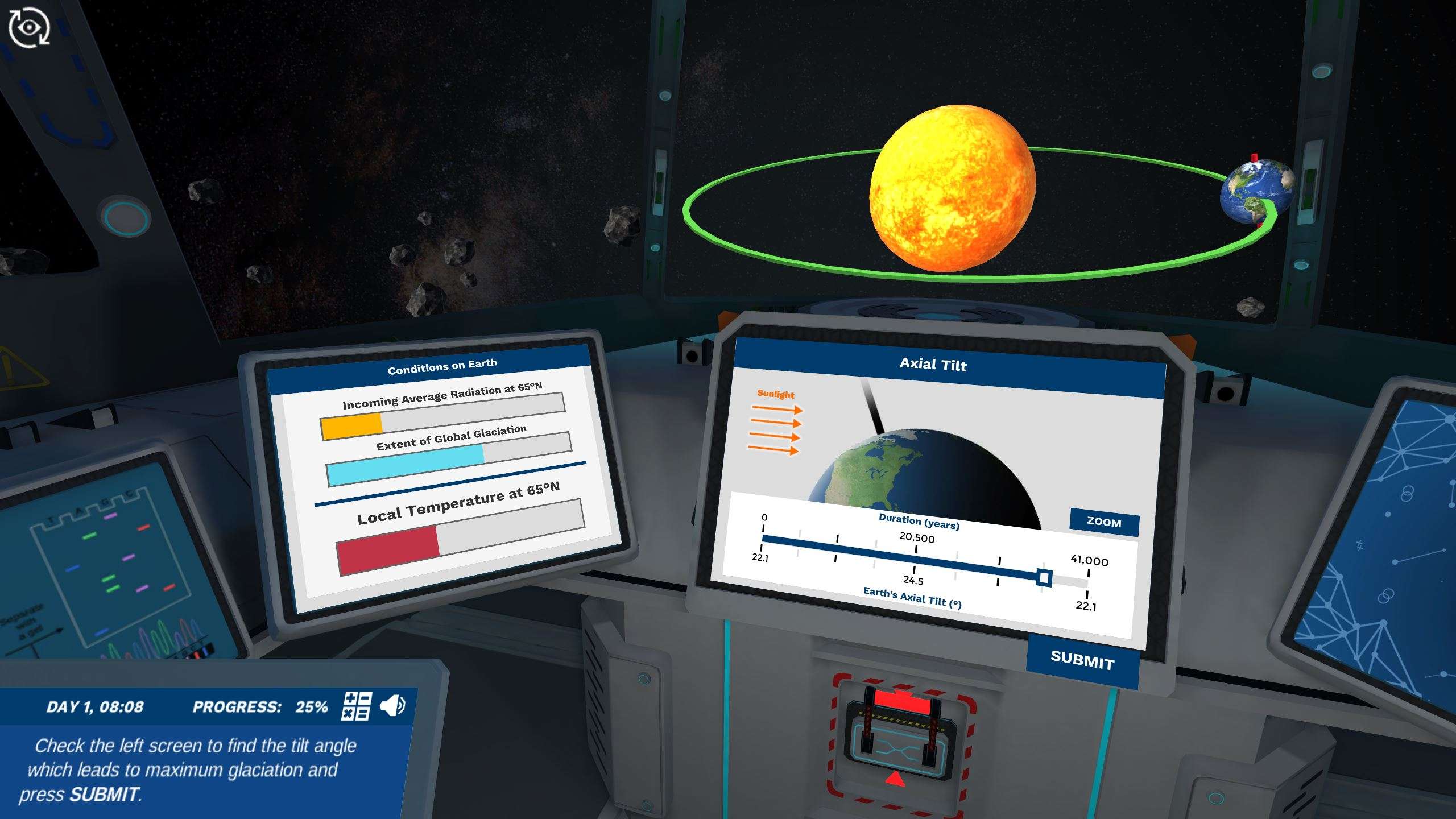Heading 1
Heading 2
Heading 3
Heading 4
Heading 5
Heading 6
Lorem ipsum dolor sit amet, consectetur adipiscing elit, sed do eiusmod tempor incididunt ut labore et dolore magna aliqua. Ut enim ad minim veniam, quis nostrud exercitation ullamco laboris nisi ut aliquip ex ea commodo consequat. Duis aute irure dolor in reprehenderit in voluptate velit esse cillum dolore eu fugiat nulla pariatur.
Block quote
Ordered list
- Item 1
- Item 2
- Item 3
Unordered list
- Item A
- Item B
- Item C
Bold text
Emphasis
Superscript
Subscript
About This Simulation
Join Dr. One in a spaceship and explore the drivers of natural climatic variations during the Earth’s past. Learn about the natural factors which can change the climate on Earth, and analyze the timescales and geographical extent of their effects.
Learning Objectives
- Connect astronomical, geological, and biological factors to climate change in Earth’s history
- Differentiate climate impacting factors by the duration and scale of their effect
About This Simulation
Lab Techniques
Related Standards
- ESS2.A-H3
- HS-ESS2-4
Learn More About This Simulation
Climate change is one of the biggest challenges of our time. In this simulation, you will learn which astronomical, geological, and biological factors caused climate change in Earth’s past. The geological record reveals that natural climate variations occurred over short, medium, and long timescales. Learning about Earth’s past climate is crucial for understanding global warming today.
Explore climate change on all timescales
The Earth’s climate system is very complex. On our spaceship, we simulate Earth’s past climate variations with three different models. You can also explore evidence and learn how scientists gain information on past climatic conditions.
Change the Earth’s tilt angle to simulate interglacials and glacials (i.e. warmer and colder climatic periods within the current Ice Age). Journey through 250 million years of plate tectonic activity to learn how mountains, ocean currents, and the supercontinent Pangaea influenced Earth’s climate. Explore how slow changes in land cover and vegetation compare to the intense climatic effects of volcanic eruptions and asteroid impacts. And finally, understand how volcanic activity can cause both global warming and cooling - but on very different timescales.
Fast-forward through Earth’s past climate history
Geological processes take millions of years to change Earth’s surface and influence the climate. In this simulation, you can speed up natural processes and their effects. In just a few seconds, observe how Earth’s climate changes over thousands or millions of years. The simulation also visualizes climatic effects on Earth's ice sheets and oceans. Compare the duration and intensity of different factors, or zoom out to see Earth from space. All of this will help you to better understand the global climate system!
Calibrate the climate model
Plant forests or trigger volcanic eruptions and asteroid impacts to learn how they affect Earth’s climate on different timescales. Gather climate data and make your own observations. Can you predict how the effects combine and calibrate the climate model?
For Science Programs Providing a Learning Advantage
Boost STEM Pass Rates
Boost Learning with Fun
75% of students show high engagement and improved grades with Labster
Discover Simulations That Match Your Syllabus
Easily bolster your learning objectives with relevant, interactive content
Place Students in the Shoes of Real Scientists
Practice a lab procedure or visualize theory through narrative-driven scenarios


FAQs
Find answers to frequently asked questions.
Heading 1
Heading 2
Heading 3
Heading 4
Heading 5
Heading 6
Lorem ipsum dolor sit amet, consectetur adipiscing elit, sed do eiusmod tempor incididunt ut labore et dolore magna aliqua. Ut enim ad minim veniam, quis nostrud exercitation ullamco laboris nisi ut aliquip ex ea commodo consequat. Duis aute irure dolor in reprehenderit in voluptate velit esse cillum dolore eu fugiat nulla pariatur.
Block quote
Ordered list
- Item 1
- Item 2
- Item 3
Unordered list
- Item A
- Item B
- Item C
Bold text
Emphasis
Superscript
Subscript
A Labster virtual lab is an interactive, multimedia assignment that students access right from their computers. Many Labster virtual labs prepare students for success in college by introducing foundational knowledge using multimedia visualizations that make it easier to understand complex concepts. Other Labster virtual labs prepare learners for careers in STEM labs by giving them realistic practice on lab techniques and procedures.
Labster’s virtual lab simulations are created by scientists and designed to maximize engagement and interactivity. Unlike watching a video or reading a textbook, Labster virtual labs are interactive. To make progress, students must think critically and solve a real-world problem. We believe that learning by doing makes STEM stick.
Yes, Labster is compatible with all major LMS (Learning Management Systems) including Blackboard, Canvas, D2L, Moodle, and many others. Students can access Labster like any other assignment. If your institution does not choose an LMS integration, students will log into Labster’s Course Manager once they have an account created. Your institution will decide which is the best access method.
Labster is available for purchase by instructors, faculty, and administrators at education institutions. Purchasing our starter package, Labster Explorer, can be done using a credit card if you are located in the USA, Canada, or Mexico. If you are outside of North America or are choosing a higher plan, please speak with a Labster sales representative. Compare plans.
Labster supports a wide range of STEM courses at the high school, college, and university level across fields in biology, chemistry, physics, and health sciences. You can identify topics for your courses by searching our Content Catalog.















